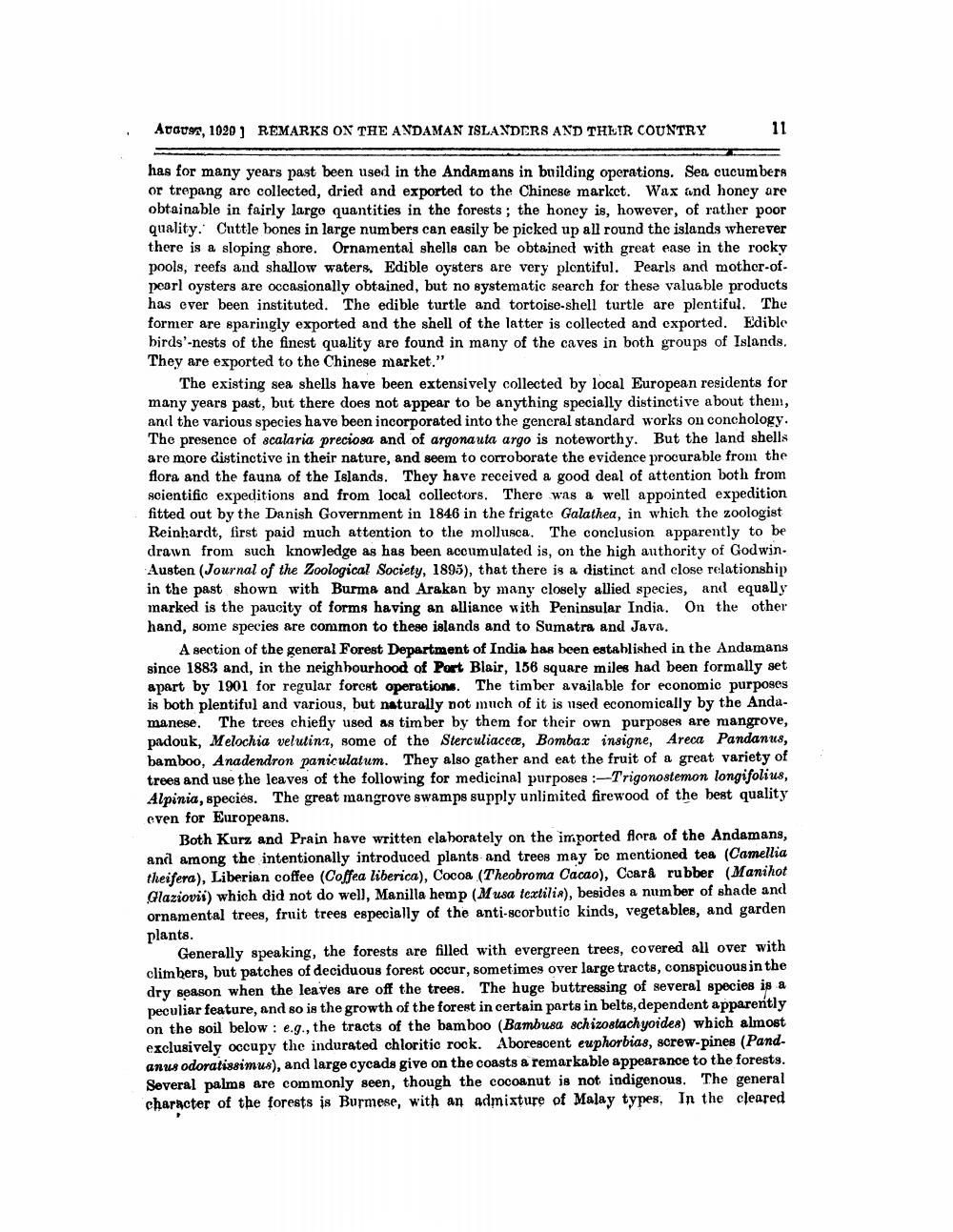________________
Atauer, 10201 REMARKS ON THE ANDAMAN ISLANDERS AND THEIR COUNTRY 11
- has for many years past been used in the Andamans in building operations. Sea cucumbers or trepang are collected, dried and exported to the Chinese market. Wax and honey are obtainable in fairly large quantities in the forests; the honey is, however, of rather poor quality. Cuttle bones in large numbers can easily be picked up all round the islands wherever there is a sloping shore. Ornamental shells can be obtained with great ease in the rocky pools, reefs and shallow waters. Edible oysters are very plentiful. Pearls and mother-ofpearl oysters are occasionally obtained, but no systematic search for these valuable products has ever been instituted. The edible turtle and tortoise-shell turtle are plentiful. The former are sparingly exported and the shell of the latter is collected and exported. Edible birds'-nests of the finest quality are found in many of the caves in both groups of Islands, They are exported to the Chinese market."
The existing sea shells have been extensively collected by local European residents for many years past, but there does not appear to be anything specially distinctive about them, and the various species have been incorporated into the general standard works on conchology. The presence of scalaria preciosa and of argonauta argo is noteworthy. But the land shells are more distinctive in their nature, and seem to corroborate the evidence procurable from the flora and the fauna of the Islands. They have received a good deal of attention both from scientific expeditions and from local collectors. There was a well appointed expedition fitted out by the Danish Government in 1846 in the frigate Galathea, in which the zoologist Reinhardt, first paid much attention to the mollusca. The conclusion apparently to be drawn from such knowledge as has been accumulated is, on the high authority of Godwin. Austen (Journal of the Zoological Society, 1895), that there is a distinct and close relationship in the past shown with Burma and Arakan by many closely allied species, and equally marked is the paucity of forms having an alliance with Peninsular India. On the other hand, some species are common to these islands and to Sumatra and Java.
A section of the general Forest Department of India has been established in the Andamans since 1883 and, in the neighbourhood of Port Blair, 156 square miles had been formally set apart by 1901 for regular forest operations. The timber available for economic purposes is both plentiful and various, but naturally not much of it is used economically by the Andamanese. The troes chiefly used as timber by them for their own purposes are mangrove, padouk, Melochia velutina, some of the Sterculiacee, Bombax insigne, Areca Pandanus, bamboo, Anadendron paniculatum. They also gather and eat the fruit of a great variety of trees and use the leaves of the following for medicinal purposes :-Trigonostemon longifolius, Alpinia, species. The great mangrove swamps supply unlimited firewood of the best quality even for Europeans.
Both Kurz and Prain have written elaborately on the imported flora of the Andamans, and among the intentionally introduced plants and trees may be mentioned tea (Camellia theifera), Liberian coffee (Coffea liberica), Cocoa (Theobroma Cacao), Coard rubber (Manihot Glaziovis) which did not do well, Manilla hemp (Musa textilir), besides a number of shade and ornamental trees, fruit trees especially of the anti-scorbutic kinds, vegetables, and garden plants.
Generally speaking, the forests are filled with evergreen trees, covered all over with climbers, but patches of deciduous forest occur, sometimes over large tracts, conspicuous in the dry season when the leaves are off the trees. The huge buttressing of several species is a peculiar feature, and so is the growth of the forest in certain parts in belts, dependent apparently on the soil below : e.g., the tracts of the bamboo (Bambusa schizostachyoides) which almost exclusively occupy the indurated chloritic rock. Aborescent euphorbias, screw-pines (Pandanus odoratissimus), and large cycads give on the coasts a remarkable appearance to the forests. Several palms are commonly seen, though the cocoanut is not indigenous. The general character of the forests is Burmese, with an admixture of Malay types. In the cleared




